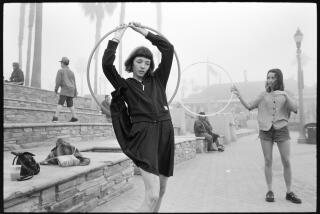Blending Sight With the Sound : Image: Photographers can help build a musician’s career, giving the right look, making even the anonymous appear famous.
- Share via
Blame it on MTV.
Rock ‘n’ roll music has become so visual these days that we are likely to see MichaelJackson’s newest glove or Madonna’s latest leather-and-steel bustier before we actually hear their new song on the radio.
Sometimes it seems the look is as important as the sound. And in the image-crazy record industry, the status of the rock photographer has risen as quickly as a strobe flash.
“Musicians have art directors and makeup people,” said Henry Diltz of North Hollywood, who began taking photographs of rock bands 25 years ago. “Some of these guys look like they spend more time on their hair than on their music.”
That’s where the rock photographer comes in.
At the top of the business are people like Neil Zlozower of Los Angeles, whose work appears in numerous magazines, and Diltz, whose portraits have been used as album covers for everyone from the Lovin’ Spoonful to Jackson Browne.
There is just as much work in the lower echelons of the business. Every day a new band comes to Los Angeles hoping to make it on the club circuit and attract a recording contract. These bands need 8x10 glossy photographs to include with the four-song cassette tapes they send to booking agents and record company executives.
People like Paul Bononi and George DeLoache and Meredith Day are ready and willing to help. These Valley photographers might otherwise be doing weddings and boudoir portraits; instead they are able to earn a decent living by doing the bulk of their business in rock ‘n’ roll. It is their business to make musicians look good.
“You can’t discount how important the picture is. When the demo tape goes to the record company and when the guy plays that tape, he is holding the picture, looking at it,” said Day, who works out of a North Hollywood studio and has focused on rock for the past five years. One of the bands that she photographs, Expose, has hit it big. A dozen other clients are still trying. “It’s crucial for the musicians to look larger than life. I try to make even the new people look already famous and worth a lot of money.”
Bands spend a significant amount of money to acquire photogenic appeal. Day charges $250 for a two-hour session that will produce several usable photographs. Bononi, also of North Hollywood, offers a $150 economy deal for bands that are “just scraping by.” DeLoache, a Studio City photographer, charges as much as $700 a day plus expenses.
“You’re not just making pretty pictures, you’re creating an advertisement,” said DeLoache, who photographs local bands such as Rings of Saturn and Wanted. “If I illustrate the band properly, then 16-year-old kids will go out and see their club dates.”
DeLoache, like Diltz and Day, got into the business because he is, himself, a musician. He has been snapping pictures of rock musicians for about 20 years and has seen the nature of the work change. As the value of image increases, so does the complexity of taking photographs. “Every item of clothing, every posture means something,” he says.
Diltz bemoans this new attention to glamour. Although most of his photographs are live-action shots, his work has changed as well.
“Back in the old days, we used to just pile in the car and drive out to the desert and take pictures,” Diltz said.
Now, a photographer will likely have “pre-shoot consultations” with the band. This involves listening to the music. Some photographers insist on seeing the band perform to get a better feel for the image.
Next, the musicians and photographers plan a strategy. Some bands want the “street” look and others want to look “pretty.” Some don’t want any makeup and others want their hair teased just so.
“It seems like every time you go to do your photo shoot, your hair never goes the way you want it,” said Ralph Saenz, singer for a Valley band called LongGone.
Different styles of music require different styles of photography. A loud and long-haired heavy metal band might be best illustrated by a highly contrasted picture. The relaxed music of a rhythm-and-blues singer might suggest soft lighting.
The shoot itself calls for more than just strobes and a camera. Bands often bring hairdressers and makeup artists and wardrobe changes. Since some musicians in their mid-30s are hoping to attract a teen-age following, they require what DeLoache calls “Smooth and Fluff”--smooth the skin and fluff the hair.
Says Day: “You have to assess the bone structure of the person and put them in a position where all their angles look complimentary.”
A band with a good-looking photograph is more likely to get booked into a club, promoters say. And the photograph, when stapled to a billboard outside the club, can lure customers as they stalk Sunset Boulevard, choosing between hangouts like the Roxy or the Whiskey.
“As much as you’d like to think that you can’t judge a book by its cover, you do,” said Robert Seidenberg, executive editor at Creem magazine, which has covered rock music since 1969.
The benefits of a pretty smile, or scowl, aren’t lost on record industry executives, either.
“We have to see the image,” said Stacye Branche of A&M; Records. “If we see it, then the public will see it.”
Says Mike Faley, president of Metal Blade Records: “It may be the look that will capture your attention. A band wins or loses on its music, but you have to be conscious of the image. If you sign a band, you’re going to have to sell that image.”
With all this in mind, the band LongGone recently hired Robert John, an expensive photographer who had earned kudos for his work with Guns ‘N’ Roses. Members of LongGone spent three hours posing under various lights and in various clothing. They went for the “hard, yet earthy” look as opposed to “glam” or “street.”
The photos have since appeared in several rock ‘n’ roll magazines and will be included in future submissions to record companies.
“It seems like music is only 50% of the challenge,” Saenz said. “It took me a long time to learn that. Having a good promotional shot is very, very important. In this day and age of video, it’s just part of the business.”
More to Read
The biggest entertainment stories
Get our big stories about Hollywood, film, television, music, arts, culture and more right in your inbox as soon as they publish.
You may occasionally receive promotional content from the Los Angeles Times.











